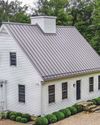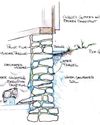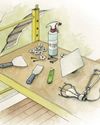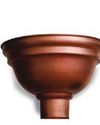
When the only thing wrong with an old plaster wall is isolated damage, you can patch-plaster it- which requires familiarity with three-coat plastering techniques-or you can make a drywall patch as described here. The hardest part will be taping the joint between the drywall (e.g., Sheetrock) and the original plaster so that the patch is undetectable. Do it right and you can avoid most of the dusty sanding between coats and at the end.
MAKING THE PATCH
Remove any crumbling plaster around the area to be patched. Cut the hole opening to a regular shape, preferably back to the nearest stud. A regular shape makes the drywall patch easier to cut; exposing studs lets you nail the patch directly to the studs.
Secure edges of the old plaster with wood screws. If the plaster is sound but the plaster keys holding it to lath have broken, use screws along with plaster washers to stabilize the plaster. Cut a drywall patch to fit neatly in the opening. The gap between patch and plaster should be minimal so that the tape will span the joint. Shim the drywall patch as needed to bring it flush with the surface of the plaster. Nail or screw the drywall in place, with fastener heads set slightly below the surface (dimpled), but without breaking the paper face.
If the hole to be patched is small and misses nearby studs, the drywall may be screwed into the wood lath. (Nails won't hold.)
TAPING TECHNIQUE
You'll need a 6" flexible taping knife, a 12" flexible taping knife or a float, a hawk, and a sanding sponge, as well as remnant drywall, joint compound, and either paper or fiberglass-mesh tape (used to bridge drywall joints).
この記事は Old House Journal の September - October 2024 版に掲載されています。
7 日間の Magzter GOLD 無料トライアルを開始して、何千もの厳選されたプレミアム ストーリー、9,000 以上の雑誌や新聞にアクセスしてください。
すでに購読者です ? サインイン
この記事は Old House Journal の September - October 2024 版に掲載されています。
7 日間の Magzter GOLD 無料トライアルを開始して、何千もの厳選されたプレミアム ストーリー、9,000 以上の雑誌や新聞にアクセスしてください。
すでに購読者です? サインイン

Navigating the Lumberyard - Here's some lumber lingo you should know before you venture into a lumberyard.
Here's some lumber lingo you should know before you venture into a lumberyard. Almost everyone fixing an old house will end up at a lumberyard-whether it's a local supplier or the organized aisles of a big-box home-improvement store.

a farmhouse renewed
Sensitive renovations and restoration work preserved a house that dates to 1799.

AN OVERVIEW OF METAL ROOFING
METAL ROOFS ARE RESURGENT, FOR GOOD REASONS.

ENDURING BEAUTY IN WALLS of STONE
Now back in the family who had been here since 1830, the old farmhouse is again ready for generations to come. Additions dating to 1840 and the 1950s were preserved.

ARCHITECTURAL DETAILS COME TO LIFE
Owners and their designer celebrate the unique features of a 1912 Arts & Crafts Tudor.

For a Wet Basement Wall
If there's problem common to old houses, it's a wet basement. I'm not talking about occasional flooding, but rather a basement that apparently seeps or leaks after even a rain shower or during snowmelt. Several approaches are available; sustainable solutions will get to the root of the problem.

Patching a Plaster Wall
Fix a hole in the wall with a few common tools and some drywall supplies. Practice your technique!

Roofing & Siding
Make note of these historical and unusual materials for the building envelope.

The Riddle of the water
When water incursion happens, the roof isn't necessarily the culprit. Maybe snaking a drain line, or clearing debris from a clogged gutter, temporarily will stem a leak. But a recurring problem usually means other forces are at work. It takes persistence-and a team with the right skills and patience—to identify the source and apply a solution.

Light-filled Craftsman Redo
For a dark kitchen in a 1914 Illinois house, the trick was anchoring white expanses with woodsy warmth.